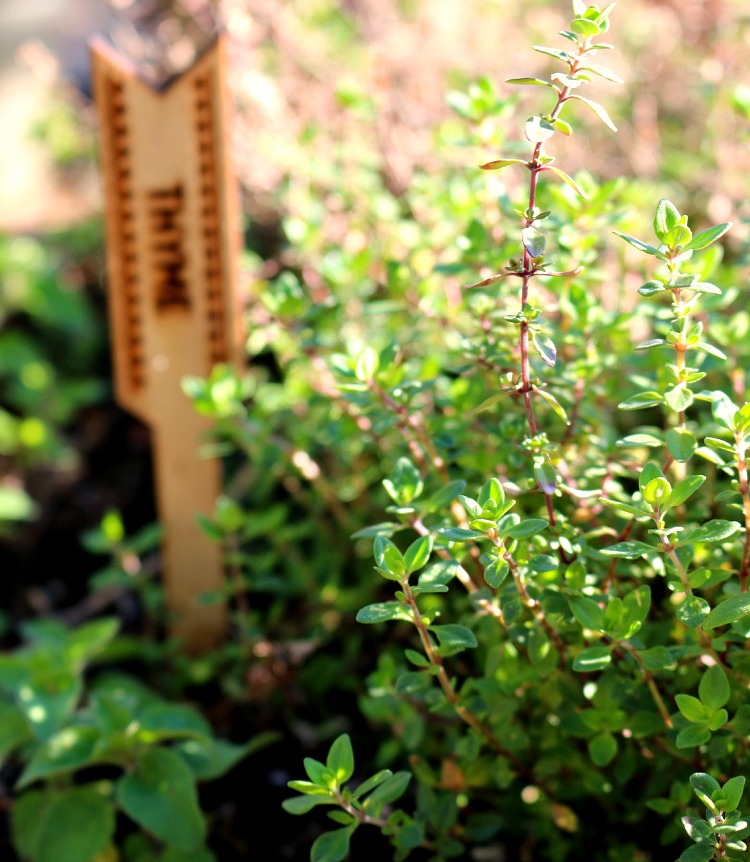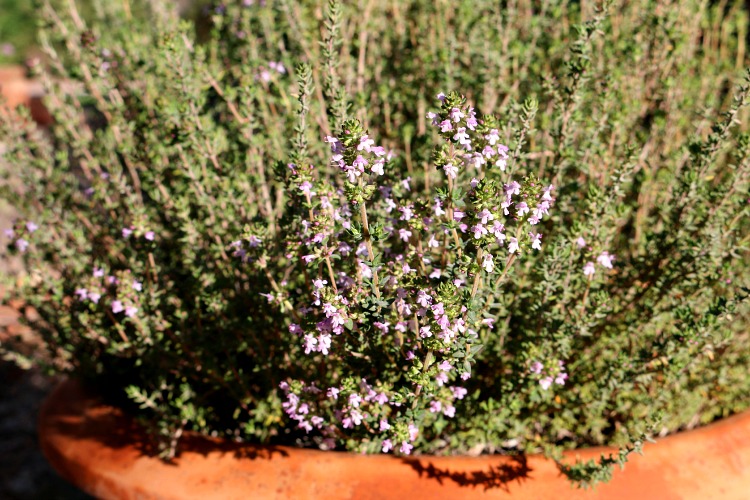
The herb Lemon Thyme growing in my herb garden.
Thyme (pronounced “time”) is a fragrant, small-leafed, woody-stemmed culinary herb. The herb was used thousands of year ago by the ancient Egyptians for embalming. Romans used it in their homes and in cheese and drinks; they are believed to have helped to spread the herb across Europe. The Greeks burned it as incense in their temples and put it in their baths, believing it was a source of courage. Today the culinary herb is used frequently in Mediterranean, Italian and Provençal French cuisines. It pairs well with lamb, poultry, tomatoes, and is often used in baked goods, drinks, soups, stews, stocks and sauces.
COOKING WITH THE HERB THYME: Thyme is a great herb to use in many dishes, including soups stews, meat dishes, drinks and baked goods. The herb comes in a variety of flavors including English thyme, French thyme, lemon thyme and winter thyme. They have a similar flavor with the exception of the lemon thyme; the lemon is very pronounced, making it an ideal addition to chicken, fish or in salad dressings. It also pairs well with a number of drinks, including lemonade.
GROWING THE HERB THYME: This herb is remarkably easy to grow. Thyme is a perennial, meaning it grows back year after year. Over time the herb will spread out, so keep this in mind when planting. This perennial is extremely versatile in the garden; thyme can be tucked into corners, planted in large pots or containers, planted between stones, or set on the front edge of a flower or vegetable bed. The creep varieties also makes for beautiful ground cover and bloom with a tiny purple flower, which is known to attract bees.
This sturdy herb does best in full sun, or even partial shade in hot climates. It enjoys moist, rich soil, and is remarkably drought-tolerant once established. Well-drained soil is a must; the roots will rot in soggy ground. If planting in pots, fertilize during peak growing periods. In early spring a little pruning is needed to remove dead stems and encourage new growth. As with most herbs, regular snipping during the growing season improves the plant growth.
PURCHASING FRESH HERBS: The herb thyme is usually sold in little bundles of stems with the small leaves attached. Thyme should appear fresh, not wilted. If you shake the container you can tell if the stems are still strong and well hydrated. If they flop around in the container they are not fresh. It is normal to find the color that varies from gray to a yellowed edge. If the leaves are shedding than this indicates the bunch is past its prime. Lemon thyme normally has a yellow color, while the other varieties vary in shades of green to gray.
STORING YOUR HERBS: Place freshly cut thyme in a plastic produce bag in the refrigerator, preferably not in the vegetable bin, as it prefers the colder temperatures when stored.
CHOOSING THE RIGHT VARIETY OF THYME: Dozens of varieties of thyme are available, but those interested in the best culinary thymes have only a handful of choices. The herbs best for flavor, as well as ease of use, are those with low-growing, shrubby types, which include: English, French, lemon, and winter thyme.
HARVESTING THE LEAVES: The leaves can be harvested from spring into early winter. In New Mexico is grows from April into December. The herb is hearty and will only die off after several night of a hard freezes: 32 degrees or below. The sturdier stems and small but tender, flavorful leaves make thyme easy to strip. This can be done by by holding the tip of the stem between the thumb and forefinger of one hand, and then gently sliding the thumb and forefinger of the other hand down the stem, removing the leaves. (See image C) The herb is best fresh but can be picked in the late fall and dried and stored for the winter months. To dry the herbs, simply wash and lay the stems out onto a large service for several days. Placing them on a cookie sheet is recommended. After they have dried for several days, remove the leaves using the technique described above. Store them in airtight mason jars or repurposed old spice bottles.

Thyme the Herb

Leave a Reply